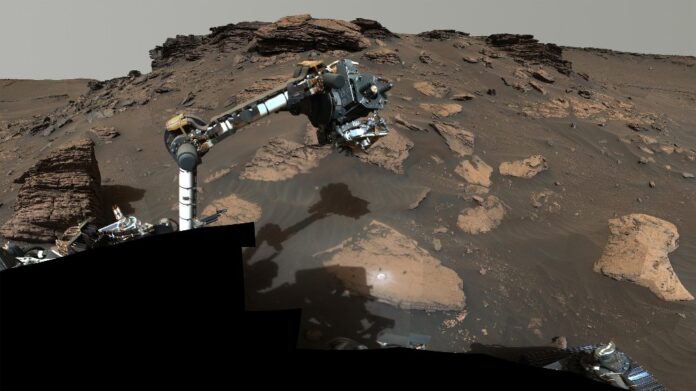When NASA landed the Perseverance rover on Mars complete with an instrument package capable of identifying organic molecules, the Agency chose the Jezero Crater, the site of an ancient water-formed delta dating back 3.5 billion Earth years. The goal was to look for signs of ancient Martians, not the Martians of H.G. Wells’ “War of the Worlds,” but rather microorganisms like the ones that killed off the Martians after they arrived.
Onboard Perseverance is an instrumentation package that goes by the acronym SHERLOC which stands for Scanning Habitable Environments with Raman and Luminescence for Organics and Chemicals. Using SHERLOC, Perseverance has been sampling sedimentary rocks laid down by the water that flowed on the Martian surface earlier in its history.
What does the presence of organic molecules in samples tell us about the existence of past or present life on Mars? Although organic molecules may form from chemical processes where life is not present, it usually is a good sign of its existence. And Perseverance isn’t the first Martian lander or rover to discover organic molecules. The Viking landers, and now defunct rovers, Spirit, and Opportunity, have all indicated that Mars could or did harbour life in the past. Curiosity, the other active Martian rover in the Gale Crater has made similar discoveries. The difference between the two rovers, however, is one of both quantity and quality when looking at the Perseverance samples. Perseverance has found far more organic molecules than its sister rover and is caching the samples for a future mission to find, gather and return to Earth for study.
NASA takes a cautious approach in claiming life once existed on Mars even though it has described the Jezero Crater as “an ancient habitable environment.” Right from the two Viking landers back in 1976 with experiments on board designed to measure chemical signatures indicating the presence of past life, the Agency has presented organic chemistry findings without claiming proof of past life on the planet. Seen in retrospect some 46 years later, the Viking lander experiments provided evidence of past life according to a growing number of scientists who rate the certainty today at 99%.
And inside NASA, the excitement is growing around Perseverance findings. A September 15, 2022, NASA press release quotes Sunanda Sharma, one of the scientists involved with SHERLOC who states, “It’s clear that we’re uncovering a bigger story than what’s happening in Jezero Crater. We found signals that we think are possibly from organic matter on every target that we’ve observed.”
The word “intriguing” is being used to describe Perseverance results coming from sedimentary rocks on Mars that are of the same type known for preserving fossils and evidence of life here on Earth. In two months the 12 sampling tubes plus additional ones collected in the next few weeks will be deposited and secured at a location near the base of the delta.
The plan is to recover the samples in a dual mission that involves a multipurpose orbiter and a lander accompanied by two helicopters. The planned launches are in 2027 and 2028 respectively. The lander also has an onboard rocket.
The recovery mission will have the helicopters and Perseverance working together to collect the cached samples and bring them back to the lander where the onboard robotic arm will transfer them to a secured compartment contained within the rocket. The rocket will then take off and rendezvous and dock with the orbiter to safely stow the samples for the return to Earth. The containment system includes a heat shield to protect the samples and parachute to deploy upon reentry into Earth’s atmosphere. Pulling this off will set all kinds of firsts for space exploration. And once the samples are back here on Earth, we may finally come face-to-face with Martians from the past.
Is there a chance that living Martians will be onboard the samples being returned? No! So no extraterrestrial Martian invasion, nor any outbreak from an alien microorganism as depicted in Michael Crichton’s “Andromeda Strain.”








